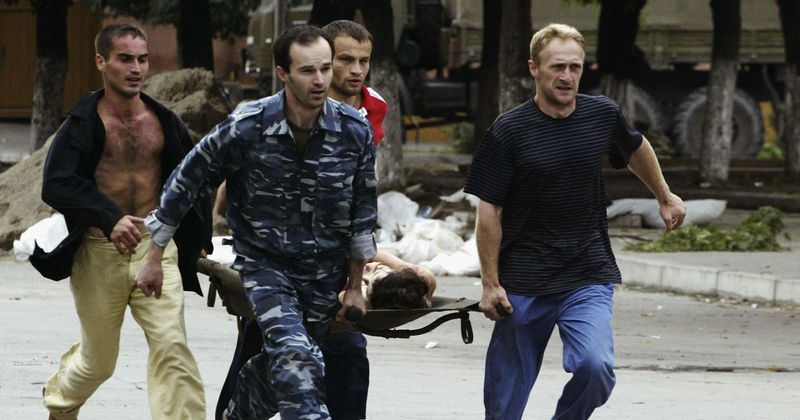This Day in History: Beslan School hostage crisis jolted Russia in 2004 and left 330 dead, most of them children

September 1, 2004, started out like any other day in Beslan, a town in the Republic of North Ossetia-Alania situated in the Caucasus region of Russia. School No 1 — one of the seven schools in the town — was holding an assembly featuring all its students, faculty and parents of the children to celebrate the traditional start of the Russian school year, referred to as "First Bell" or Knowledge Day. However, the day soon turned deadly when Islamic militants belonging to the Ingush and Chechen communities stormed the school and took 1,100 people as hostages. The crisis would last for three days, ending on September 3 in a deadly standoff as Russian security forces stormed the building.
Who were the militants?
The hostage-takers were the Riyad-us Saliheen, sent by Chechen warlord Shamil Basayev, who demanded Russian withdrawal and recognition of the independence of Chechnya, which has long had a conflict with Russia dating back to the 18th century and beyond. In the 1990s, two Chechen wars took place between the Chechens and the Russians, resulting in a large number of casualties on both sides with vast destruction of the Chechen capital in the Battle of Grozny.
Basayev only issued a statement claiming responsibility for the attack days after it ended. He said that he originally planned to seize at least one school in either Moscow or Saint Petersburg, but lack of funds forced him to pick North Ossetia, "the Russian garrison in the North Caucasus," according to BBC.
According to The Guardian, Russia officially states that 32 militants participated directly in the seizure, one of whom was taken alive while the rest were killed on spot. However, many of the surviving hostages and eyewitnesses claim there were many more captors, some of whom may have escaped, according to reports.

The three-day seige
The militants launched their raid on the school shortly after 9 am local time, forced all hostages into an overcrowded gym and executed a number of teachers and parents. The hostage-takers reportedly wore suicide belts and bombs were strapped to the basketball nets in the gymnasium. The attackers mined the gym and the rest of the building with IEDs and surrounded it with tripwires.
After gathering the hostages in the gym, the attackers singled out 15–20 of whom they thought were the strongest adults among the male teachers, school employees and fathers, and took them into a corridor next to the cafeteria on the second floor, where a deadly blast soon took place.
Soon the Russian police, Internal Troops, Russian Army forces, Spetsnaz (including the elite Alpha and Vympel units of the (FSB) Russian Federal Security Service), and the OMON special units of the Russian Ministry of Internal Affairs (MVD) established a security cordon around the school. While international news outlets such as BBC and CNN covered the crisis extensively, the crisis was not broadcast on three major state-owned television networks. Additionally, Russian state-controlled television only reported official information about the number of hostages during the course of the crisis. The figure of 354 people was persistently given, angering the hostage-takers who further abused the hostages and prompted them to go on a "hunger strike".

The lack of food and water took a toll on the young children who were hostages, many of whom were made to stand in the hot, tightly packed gym. Children fainted and hostages resorted to drinking their own urine to quench their thirst. Many of the children were so fatigued on the third day that when an explosion occurred in the gym and the Russian forces stormed the school, they were barely able to flee from the carnage.
During the crisis, President Vladimir Putin, who was then serving his first term, only gave out a statement on the second day of the siege, commenting, "Our main task, of course, is to save the lives and health of those who became hostages. All actions by our forces involved in rescuing the hostages will be dedicated exclusively to this task," in a meeting with King Abdullah II of Jordan. He would comment on it again until the day after the siege ended.
On the third day of the siege, when paramedics approached the school, an explosion was heard from the gym. A second explosion took place seconds later and the resulting fire led to the collapse of the roof, turning the room into an inferno. Local militia opened fire and the militants returned fire. A number of people were killed in the crossfire.
Aftermath

The official statement was that the militants set off the first explosion and that grenades fired by Russian troops could not have sparked the fire. However, an independent investigation conducted in 2006 by explosives expert Yury Savelyev contradicted that assertion. "We have known for a long time that security services were to blame for killing many of the hostages. But the Prosecutor-General's Office flatly refuses to listen to the testimony of eyewitnesses who saw it," said a statement according to RFERL. In all, 334 people died, not counting the hostage-takers. Of the casualties, 186 were children.
In 2017, the European Court of Human Rights (ECHR) ruled that the Russian government must pay the victims a total of €2.9M ($3.2M) as compensation. According to the ECHR's findings, the Russian authorities violated the rights to life, to an effective remedy, and to provide just compensation (Articles 2, 13, 41 of the European Convention on Human Rights). It also noted that the Russian authorities received information about the planned attack at least several days before the terrorist attack, but did not take "adequate action" — they did not warn the school administrations and did not increase security measures.